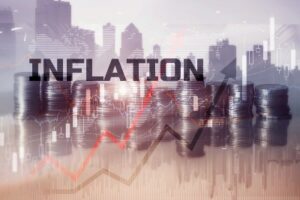
Comparison of 23 major Metropolitan Statistical Areas (MSAs) across two key metrics enabled WalletHub to determine Cities Where Inflation is Rising the Most.
In August 2022, according to WalletHub, inflation was 8.3 higher than in August 2021.
WalletHub used the Consumer Price Index to determine cities with the most inflation by comparing two months prior and one year prior to obtain a snapshot of how inflation has changed in the short and long term in American cities.
Inflation is rising the most in Phoenix, Ariz., followed by Atlanta, Tampa, Miami and Dallas. Cities with the last rising rate of inflation are Anchorage, San Francisco, New York, Los Angeles and Honolulu.
Experts offer opinions on factors driving inflation in the U.S. in 2022.
“Inflation is caused by persistent increases in demand and/or persistent decreases in supply,” said University of Delaware Professor Burton Abrams in a press release. “While we have had some supply shocks, these have stabilized. So demand would seem to be the culprit now and going forward. The Federal Reserve has had an excessively expansionary monetary policy during the pandemic and was slow to back off as the economy returned to full employment. This is the primary reason why prices have been surging, although government giveaways contributed Interestingly, the recently announced forgiveness on college borrowing debt is equivalent to a massive tax reduction, as much as a trillion dollars. This, according to most textbooks, will raise spending and the price level but not be responsible for inflation (persistent increases in prices going forward).”
Alan Green, Associate Professor and chair of the Economics Department at Stetson University, said economists categorize inflation as pushing costs or pulling demand. But today’s inflation is driven by both.
“On the supply side factors include supply chain disruptions, COVID lockdowns in China, and energy price shocks from Russia’s invasion of Ukraine,” Green said in the press release. “On the demand side, Congress and the Federal Reserve provided substantial stimulus during the pandemic in multiple forms, and it looks now like policymakers overshot a little bit with those efforts, resulting in too much money chasing not enough goods.”
Marie Duggan, professor and PhD economist at Keene State College, said raising interest rates is “a double-edged sword.” When companies buy out competitors they often use borrowed money.
“Thus, raising the interest would reduce the incentive to undertake mergers and, in that sense, would be good for consumers, as it would create more choices and help bring prices down,” Duggan said in the press release. “On the other hand, small independent firms use low interest rates to invest in new equipment and produce quality. Raising interest rates would make it harder for small independents to thrive. In reality, we have other tools that we should use to fight inflation: enforcing antitrust laws to prevent mergers and increasing funding for regulation of businesses (such as certain electricity providers), which have the market power to raise prices quite high. Private equity purchases companies, saddles them with debt, and then sells the company, resulting in the company (now laden with debt) later attempting to raise consumer prices.”
According to Associate Professor and Department Chair at Ursinus College Scott Deacle, today’s inflation is the least bad solution.
“There are no good solutions to controlling inflation because reducing inflation requires reducing the amount of money in people’s pockets relative to the amount of goods available to purchase,” Deacle said in the press release. “Raising interest rates tends to spread out the pain, though some folks lose more than others — those who must borrow money, for example, must pay higher interest rates on their loans. And those who work in businesses that depend on low-interest rates to remain profitable or expand will be harmed as well.”
What does today’s inflation mean for the future of the American economy?
“We should expect economic growth to slow (best case scenario) or to contract (worst case scenario). As the inflation rate rises, interest rates will also rise,” Professor and MSAE Program Advisor at Georgia Southern University Dr. Amanda King said in the press release. “This not only makes borrowing more expensive, but it makes planning future projects riskier for firms. As firms acquire less capital (the machines, tools, buildings, etc. needed for production), the economy grows more slowly. At the same time, households will not be able to buy as much as higher prices mean that income will not go as far. This will also slow growth in the economy. Ultimately slowing the economy down is what is needed to get inflation back under control.”
Green said that most of today’s inflation “comes from a unique circumstance — an economy emerging from a pandemic with lots of money floating around and lots of adjustments being needed to supply chains, etc. In a few years, we will likely be looking at this situation as a rare event that does not tell us much about the future. However, the shock from energy prices does reinforce that the U.S. economy is still reliant on high energy consumption, much of it from fossil fuels. Transitioning away from that dependence will help avoid future energy shocks to inflation (not to mention the many other benefits).”










